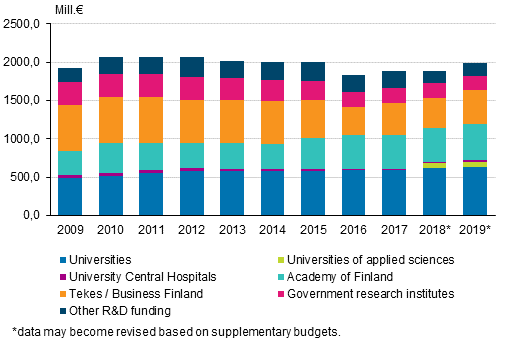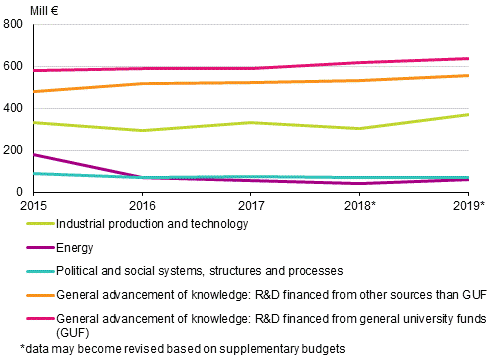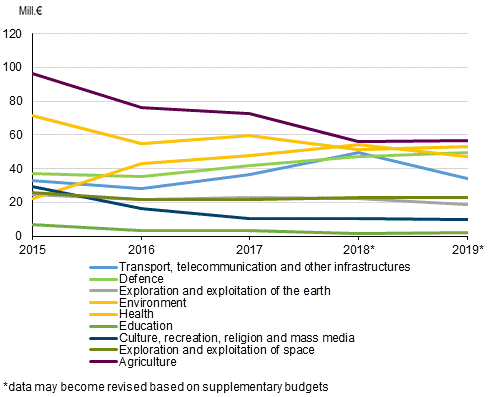Government R&D funding on the increase
In the state budget for 2019, the total appropriations for research and development activities amount to EUR 1,991.1 million. The appropriations increase by EUR 107.9 million from 2018, which translates to a 5.7 per cent nominal and 3.8 per cent real growth. The proportion of funds allocated to R&D activities of overall government spending exclusive of debt servicing is 3.7 per cent.
The GDP share of public R&D funding is an estimated� 0.83 per cent in 2019.
Table 1. Central government R&D funding and its share in government expenditure in 2018 and 2019
| Year EUR million |
Muutos 2018–2019 | ||||
| 2018 | 2019 | Milj. € | Nim. % | Reaal. % | |
| Total R&D funding | 1 883,2 | 1 991,1 | 107,9 | 5,7 | 3,8 |
| Total government expenditure | 55 675,0 | 55 347,0 | -328,0 | -0,6 | -1,7 |
| Government expenditure excluding debt servicing | 54 443,0 | 54 167,0 | -276,0 | -0,5 | -1,6 |
| R&D funding share of government expenditure excluding debt servicing | 3,5 | 3,7 | .. | .. | .. |
1. R&D funding by administrative sector
Among administrative sectors, research and development activities are clearly financed most in the Ministry of Education and Culture, whose R&D funding in the budget for 2019 amounts to EUR 1,206.1 million. The research funding of the Ministry of Education and Culture corresponds with over 60 per cent of the entire government R&D funding. The appropriations of the administrative sector increase by EUR 41.7 million, a majority of which is the result of growth in the R&D funding of the Academy of Finland. The R&D funding of the Ministry of Economic Affairs and Employment also grows, by EUR 72.7 million which is mainly caused by the increase in the R&D funding of Business Finland. Among other administrative sectors, the R&D funding of the Ministry of Transport and Communications decreases by EUR 4.5 million and the R&D funding of the Ministry of Defence increases by EUR 2.1 million in the 2019 budget.
The ministries that hand out most R&D funding, the Ministry of Education and Culture and the Ministry of Economic Affairs and Employment, are also the most R&D intensive ministries. In all, 18.8 per cent of the Ministry of Education and Culture’s expenditure and 22.3 per cent of the Ministry of Economic Affairs and Employment’s expenditure are directed at research and development activities. The average R&D intensity of administrative sectors in 2019 is 3.7. The Ministry of Finance and the Ministry of the Interior have the lowest R&D intensities.
2. R&D funding by organisation
Of the organisations, the funding for Business Finland’s R&D activities grows most. Business Finland’s investment in R&D funding grows by an estimated EUR 59.9 million in the 2019 budget, and amounts to EUR 451.2 million in total. The R&D funding of the Academy of Finland also increases, by EUR 25.9 million in the 2019 budget. Universities’ research expenditure also increases in the 2019 budget; universities finance research and development activities by EUR 630.5 million. The estimate of universities’ research and development funding for the current year is affected by the increased share of realised research expenditure in universities’ basic funding used in the calculations. Of the organisations, only R&D funding of government research institutes decreases, by EUR 5.6 million from the budget the year before.
Figure 1. Government R&D funding by organisation in 2009 to 2019

*Prior to 2018, universities of applied sciences are in the category Other R&D funding
Universities’ proportion of the total government R&D funding decreases slightly, but is still by far the highest. Universities’ share of total government R&D funding is around 32 per cent in the 2019 budget. Correspondingly, Business Finland’s share increases slightly and is around 23 per cent. The share of the Academy of Finland is around 24 per cent, remaining on level with the previous budget. Central government research institutes get around nine per cent and the share of other funding is good eight per cent. The R&D funding of universities of applied sciences is EUR 67.6 million in the 2019 budget, which corresponds with a share of good three per cent of government R&D funding. Among organisations, university central hospitals receive the smallest share of around one per cent.
3. R&D funding by social policy objective
A majority of government R&D funding is directed to universities’ research and development activities and general advancement of science, both of which increase in the budget 2019. Research funding directed at promoting industry, which includes, for example, research aimed at developing technology, grows by EUR 68.3 million and totals EUR 371.7 million in the 2019 budget. In other big objective categories, more R&D funding is allocated to energy, the R&D funding of which increases by EUR 18.5 million in the 2019 budget. The funding of the objective category political and social systems, structures and processes remains on level with the previous budget. Of the smaller objective categories, the research funding allocated to, for example, land use, transport systems and other infrastructure decreases from the previous budget by EUR 15.2 million. Investments in environmental protection research have increased in recent years, although R&D funding allocated to environmental protection decreases by EUR 7.2 million in 2019 compared to the previous budget.
Figure 2. Development of government R&D funding in 2015 to 2019 by the biggest social policy objective categories

Figure 3. Development of government R&D funding in 2015 to 2019 by the smallest social policy objective categories

4. Funding of international R&D activities
R&D funding directed at international research organisations or international R&D programmes decreases by around EUR seven million from the budget the previous year to EUR 79.0 million in the 2019 budget. The decrease is in particular caused by the decrease in Business Finland’s funding allocated to international parties. EUR 47.0 million are allocated to Europe wide R&D programmes between countries that are arranged, for example, within the framework of Horizon 2020. European international research organisations, such as CERN, the European Organization for Nuclear Research, receive EUR 18.7 million in research funding from the government budget in 2019. Around EUR eight million are directed at bilateral or multilateral R&D programmes between the governments of EU countries. The remaining EUR 5.5 million are directed at other international players for projects that have no ERA dimension.
The aim of the ERA concept is to develop the research of certain technologies in EU Member States from nation state based to Europe wide.
5. Central government research institutes
The main task of government research institutes is to acquire, produce and disseminate data as basis for political decision-making and development of society. In addition to research duties the institutes have a varying number of different expertise, supervision, training, guidance and other official functions, as well as, for example, charged and other service activities. Research institutes produce services horizontally to many different administrative branches and the rest of the public sector, as well as enterprises and third sector operators.
In addition to budget appropriations, the R&D activities of research institutes is financed by external funding consisting of income from charged services and funding from elsewhere than the institute's own budget classes. External funding mainly comes on a competitive basis from several sources and from both domestic public and private sectors and international sources. Its amount is based on the institutes’ performance targets and is thus estimated.
Budget funded R&D activities of government research institutes
The total amount of R&D funding for research institutes from their own administrative branches’ budgets for 2019 was EUR 183.5 million. Budget funding decreased by around three per cent or EUR 5.6 million from the 2018 budget. Budget funding for VTT, the Technical Research Centre of Finland, increased to EUR 78 million, but research funding for the Natural Resources Institute Finland, the National Institute for Health and Welfare and the Finnish Meteorological Institute, among others, decreased from the previous year.
Total research funding and EU funding of research institutes
Total R&D funding for research institutes (budget funding and external funding) is EUR 457.2 million in 2019, which is EUR 3.3 million more than in 2018. The increase is due to increased external funding, which grows by EUR 8.9 million to EUR 273.7 million. The share of external funding is around 60 per cent of research institutes’ funding. VTT, the Technical Research Centre of Finland, received most external funding measured in euros, the external funding share of VTT is close on 70 per cent of total funding. Research institutes estimate that they will receive EUR 58.6 million in research funding from the EU, which is around EUR 5.6 million more than one year ago. VTT’s share of EU funding is the largest, EUR 34.9 million, which increased by around EUR three million from the previous year.
Research institutes’ R&D funding by administrative sector
The research intensity of administrative sectors can, next to the funding share of actual R&D activities also be assessed by how significant a role research institutes have in the activities of each administrative branch. The social role of the administrative sectors of universities and the Ministry of Education in the field of science and research is qualitatively different and, thus, they are not included in the comparison.
An average of 28 per cent of the R&D funds of the key administrative sectors in terms of research activities is spent in their research institutes. The most research intensive administrative sectors in 2019 are the Ministry of Agriculture and Forestry and the Ministry of Transport and Communications. The Ministry of Economic Affairs and Employment, a majority of whose R&D funding is Business Finland’s funding, in turn, has the lowest research intensity.
Source: Government R&D funding in the state budget 2019, Statistics Finland
Inquiries: Heidi Pirkola 029 551 3246, tiede.teknologia@stat.fi
Director in charge: Mari Yl�-Jarkko
Updated 21.2.2019
Official Statistics of Finland (OSF):
Government R&D funding in the state budget [e-publication].
ISSN=2489-3250. 2019,
Government R&D funding on the increase
. Helsinki: Statistics Finland [referred: 28.12.2025].
Access method: http://stat.fi/til/tkker/2019/tkker_2019_2019-02-21_kat_001_en.html

